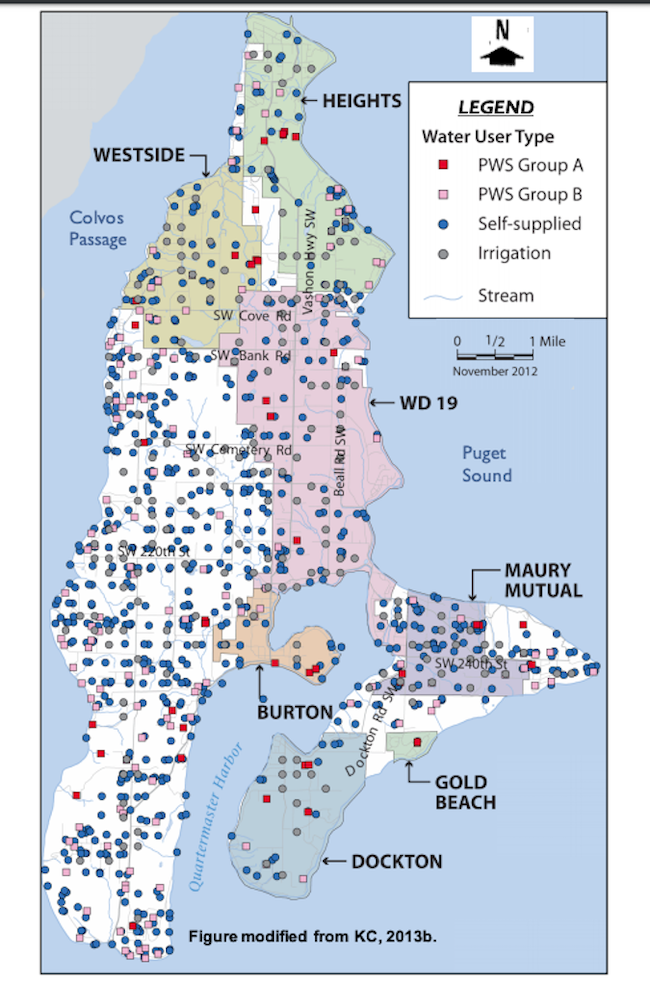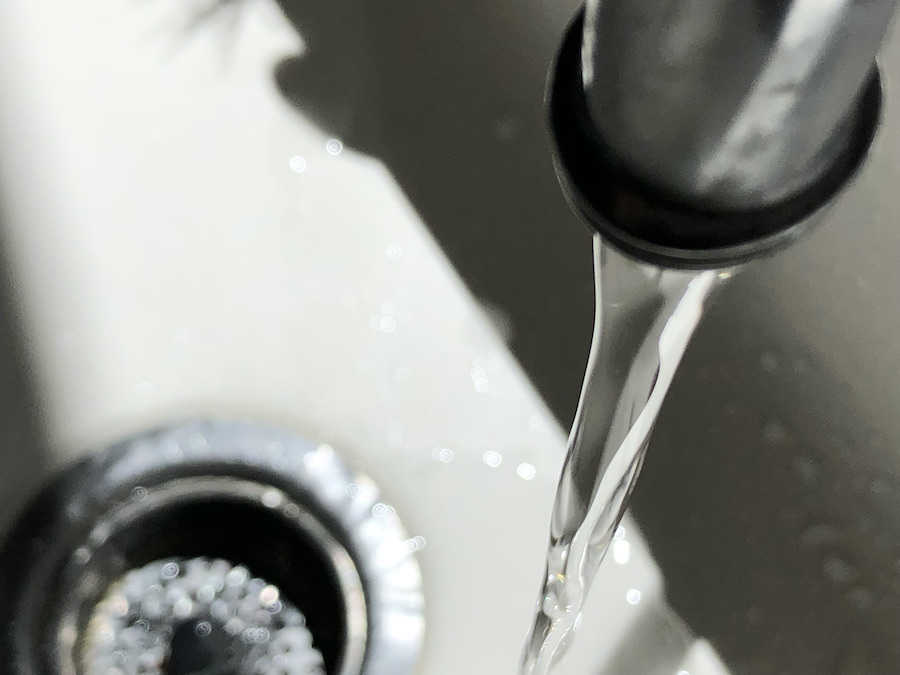This is the eighth in a monthly series of guest blog posts that Mary will be sharing about island water quality topics thru the Groundwater Protection Committee.
I used last month’s blog post to announce SafeWellsVashon, the Groundwater Protection Committee’s new program. SafeWells has two goals: gather more data on our water use and water quality, and promote smarter stewardship of our Sole Source aquifer. To appreciate the importance of these goals it helps to understand how water is managed on Vashon-Maury Island (VMI). So I’m devoting this June blog post to a critical question: Who’s guarding the water hole?
Like most things on Vashon, the answer is fuzzy. Our water monitoring system is a tangle of regulation and DIY. Almost every rule comes with an exception, and guidelines get tweaked over time. With that in mind, here’s a brief primer inspired by my own efforts as a Groundwater Committee member to make sense of the business and bureaucracy of protecting the water supply. Brace yourselves for a trip down the rabbit hole.
There are three pillars of water governance:
Usage (How much water do you need?)
Service (Who provides it?)
Quality (Is it safe?).
Overseeing the three pillars are the Washington State Department of Ecology (DOE), the Washington State Department of Health (DOH), and your local water provider (company, association or district) if you have one. The people of Washington State own the water. If you want some you need a water right. So let’s start at DOE, the dispenser of water rights and first stop for would-be water seekers, large or small, public or private.
A DOE water right is required before anyone (city, utility, business, home, etc.) can use any volume of surface water or groundwater. But the agency also grants “groundwater permit exemptions” which allow successful applicants to withdraw modest volumes of groundwater without having to obtain a water rights permit. This is why private wells are often referred to as “exempt” wells. Groundwater permit exemptions are available in four use categories: household, industrial, irrigation (of lawns and gardens smaller than a half-acre), and livestock. [Rabbit hole: In 2018, DOE lowered its exempt permit limit from 5,000 gallons per day to 950 gallons per day.] Permitting is where DOE’s role in water governance ends.
Enter DOH which monitors water quality and consumption statewide, but only for some users.

Source: Protecting Our Liquid Assets, 2012, a joint report from King County and Vashon-Maury Island Groundwater Protection Committee
On Vashon-Maury, where you get your water depends in large part on your address. Most Island homes and businesses are served by one of our seven big Group A water systems. There are 21 Group A systems in all, but I’ll focus on the largest ones, which I’m calling the Big Seven. Moving north to south, they are: Heights Water, Westside Water Association, Water District 19, Maury Mutual Water Company, Burton Water Company, Gold Beach Water Company and Dockton Water Association (see map). [Rabbit hole: The Big Seven are often referred to as “water districts” but technically speaking the only true “district” is Water District 19. Don’t ask.]
By definition, Group A providers are those that serve 15 or more households or businesses. The Big Seven Group A providers serve thousands of people, and if you’re lucky you’re one of them. The Big Seven are highly regulated by the state and run by certified operators. As a customer you don’t have to fret about your water supply because Big Seven managers do the fretting for you.
Every Big Seven draws far more than the current, 950 gallons per day exempt limit. In order to operate they had to purchase a water right from DOE. Each water rights permit—most are many decades old on Vashon—allows its holder to withdraw a certain volume. Permitted amounts and actual withdrawals vary from Big Seven provider to provider, but typically run in the millions-of-gallons-per-year range. For example, Maury Mutual, smallest of the Big Seven, delivered 5,548,906 million gallons to its 93 “connections” (i.e., households) in 2020; Water District 19, the Island’s largest provider by far, sent 118,315,704 million gallons to its 1,700 (home and business) “connections” in 2018. (WD 19’s 2018 numbers are the most recent on file with DOH.)
The Big Seven and all other Group A providers submit annual reports to DOH. The reports detail population served, number of connections, water usage, water sources, water quality, leakage, and more. (You can find all Group A stats and reports in DOH’s Sentry Database, which is really fun to rummage around in, even if you’re not a water wonk.)
If you happen to live outside a Group A service area, or if your local Group A provider is already pumping its permitted limit, you can get water in one of two ways: as part of a public Group B water system, which serves fewer than 15 connections, or from your own private well. At present, neither DOH, DOE nor King County requires existing Group B systems or individual well owners to report their water usage or water quality. King County does track water quality from a handful of monitoring wells around the Island. But by and large Group B and individual well owners operate on an honor system. Which means that the state, the county, the Island public and quite often the well owners themselves have no idea how much water they’re using or whether it remains clean and safe.
The only thing we know for sure about Group B systems is that they serve 611 connections. As for private wells, we don’t even know exactly how many there are. To find out, says John Martinak, Groundwater Committee member whose day job is managing Maury Mutual Water Company, “I would need my Ouija Board.”
John took a stab at it anyway for the SafeWellsVashon program. He tallied the number of connections reported to DOH by all Group A (3,842) and Group B (611) water systems and got a total of 4,453 Island homes and businesses served. When he subtracted that number from 5,215, King County’s current total for housing units on VMI, he found, “1,329 units that are not accounted for.” Given the squishiness of all VMI water stats, John’s more conservative guess was 1,300—or about 30 percent of island water users. That’s a yawning gap in the data, especially in Vashon’s large southwest quadrant (see map) which isn’t served by a Big Seven provider.
Filling that gap, the SafeWellsVashon mission, will help us better manage and protect our supply. The answer to that, “Who’s guarding the water hole” question? We all are!
Lead photo: Our system of water governance is a tangle of regulation and DIY. Photo credit: Mary Bruno


This information is so vital. Thank you to you and to the Groundwater Protection committee for gathering and publishing any and all information regarding water. as someone at the “consumer level”, the efforts shown here “raise my awareness” and ignite my commitment to be mindful of water and the importance to conserve and share in the stewardship of this most precious resource. It cannot be treated as a commodity. so, let’s stand together to protect water, here on the island, and where ever we travel in this world. Thank you mary. Thank you Groundwater committee.
And thank YOU, Patti.
The SAFe Wells team will be presenting and answering questions at the July 19 meeting of the Vashon-Maury Island Community Council. Please submit any questions to Mary Bruno at VMIGPC10@kingcounty.gov
To attend the online meeting, please see: http://vmicc.net/next-meeting/